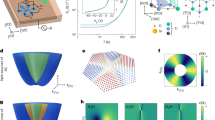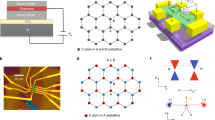Abstract
The Berry curvature dipole (BCD) is a key parameter that describes the geometric nature of energy bands in solids. It defines the dipole-like distribution of Berry curvature in the band structure and plays a key role in emergent nonlinear phenomena. The theoretical rationale is that the BCD can be generated at certain symmetry-mismatched van der Waals heterointerfaces even though each material has no BCD in its band structure. However, experimental confirmation of such a BCD induced via breaking of the interfacial symmetry remains elusive. Here we demonstrate a universal strategy for BCD generation and observe BCD-induced gate-tunable spin-polarized photocurrent at WSe2/SiP interfaces. Although the rotational symmetry of each material prohibits the generation of spin photocurrent under normal incidence of light, we surprisingly observe a direction-selective spin photocurrent at the WSe2/SiP heterointerface with a twist angle of 0°, whose amplitude is electrically tunable with the BCD magnitude. Our results highlight a BCD–spin–valley correlation and provide a universal approach for engineering the geometric features of twisted heterointerfaces.
This is a preview of subscription content, access via your institution
Access options
Access Nature and 54 other Nature Portfolio journals
Get Nature+, our best-value online-access subscription
$29.99 / 30 days
cancel any time
Subscribe to this journal
Receive 12 print issues and online access
$259.00 per year
only $21.58 per issue
Buy this article
- Purchase on Springer Link
- Instant access to full article PDF
Prices may be subject to local taxes which are calculated during checkout




Similar content being viewed by others
Data availability
The data that support the plots within this paper and other findings of this study are available from the corresponding authors upon reasonable request. Source data are provided with this paper.
References
Nagaosa, N., Sinova, J., Onoda, S., MacDonald, A. H. & Ong, N. P. Anomalous Hall effect. Rev. Mod. Phys. 82, 1539–1592 (2010).
Ma, Q. et al. Observation of the nonlinear Hall effect under time-reversal-symmetric conditions. Nature 565, 337–342 (2019).
Ma, Q., Grushin, A. G. & Burch, K. S. Topology and geometry under the nonlinear electromagnetic spotlight. Nat. Mater. 20, 1601–1614 (2021).
Xu, S.-Y. et al. Electrically switchable Berry curvature dipole in the monolayer topological insulator WTe2. Nat. Phys. 14, 900–906 (2018).
Orenstein, J. et al. Topology and symmetry of quantum materials via nonlinear optical responses. Annu. Rev. Condens. Matter Phys. 12, 247–272 (2021).
Akamatsu, T. et al. A van der Waals interface that creates in-plane polarization and a spontaneous photovoltaic effect. Science 372, 68–72 (2021).
Berry, M. V. Quantal phase factors accompanying adiabatic changes. Proc. R. Soc. Lond. A 392, 45–57 (1984).
Berry, M. V. Anticipations of the geometric phase. Phys. Today 43, 34–40 (1990).
Resta, R. Manifestations of Berry’s phase in molecules and in condensed matter. J. Phys. Condens. Matter 12, R107–R143 (2000).
Xiao, D., Chang, M.-C. & Niu, Q. Berry phase effects on electronic properties. Rev. Mod. Phys. 82, 1959–2007 (2010).
Xu, X., Yao, W., Xiao, D. & Heinz, T. F. Spin and pseudospins in layered transition metal dichalcogenides. Nat. Phys. 10, 343–350 (2014).
Sodemann, I. & Fu, L. Quantum nonlinear Hall effect induced by Berry curvature dipole in time-reversal invariant materials. Phys. Rev. Lett. 115, 216806 (2015).
Moore, J. E. & Orenstein, J. Confinement-induced Berry phase and helicity-dependent photocurrents. Phys. Rev. Lett. 105, 026805 (2010).
Kim, J. et al. Prediction of ferroelectricity-driven Berry curvature enabling charge- and spin-controllable photocurrent in tin telluride monolayers. Nat. Commun. 10, 3965 (2019).
Du, Z. Z., Wang, C. M., Lu, H.-Z. & Xie, X. C. Band signatures for strong nonlinear Hall effect in bilayer WTe2. Phys. Rev. Lett. 121, 266601 (2018).
de Juan, F., Grushin, A. G., Morimoto, T. & Moore, J. E. Quantized circular photogalvanic effect in Weyl semimetals. Nat. Commun. 8, 15995 (2017).
Rees, D. et al. Helicity-dependent photocurrents in the chiral Weyl semimetal RhSi. Sci. Adv. 6, eaba0509 (2020).
Morimoto, T. & Nagaosa, N. Topological nature of nonlinear optical effects in solids. Sci. Adv. 2, e150152 (2016).
Cook, A. M., Fregoso, B. M., de Juan, F., Coh, S. & Moore, J. E. Design principles for shift current photovoltaics. Nat. Commun. 8, 14176 (2017).
Zhang, Y. J. et al. Enhanced intrinsic photovoltaic effect in tungsten disulfide nanotubes. Nature 570, 349–353 (2019).
Osterhoudt, G. B. et al. Colossal mid-infrared bulk photovoltaic effect in a type-I Weyl semimetal. Nat. Mater. 18, 471–475 (2019).
Li, C. et al. Controllable seeded flux growth and optioelectric properties of bulk o-SiP crystals. CrystEngComm 19, 6986–6991 (2017).
Sar, H., Gao, J. & Yang, X. 2D layered SiP as anisotropic nonlinear optical material. Sci. Rep. 11, 6372 (2021).
Zhao, S. et al. Low-symmetry and nontoxic 2D SiP with strong polarization-sensitivity and fast photodetection. Adv. Opt. Mater. 9, 2100198 (2021).
Materials Explorer, SiP: mp-2798 (The Materials Project, 2020); https://doi.org/10.17188/1202120
Mortazavi, B., Shahrokhi, M., Cuniberti, G. & Zhuang, X. Two-dimensional SiP, SiAs, GeP and GeAs as promising candidates for photocatalytic applications. Coatings 9, 522 (2019).
Xiao, D., Yao, W. & Niu, Q. Valley-contrasting physics in graphene: magnetic moment and topological transport. Phys. Rev. Lett. 99, 236809 (2007).
Xiao, D., Liu, G.-B., Feng, W., Xu, X. & Yao, W. Coupled spin and valley physics in monolayers of MoS2 and other group-VI dichalcogenides. Phys. Rev. Lett. 108, 196802 (2012).
Ganichev, S. D. & Prettl, W. Spin photocurrents in quantum wells. J. Phys. Condens. Matter 15, R935–R983 (2003).
McIver, J. W., Hsieh, D., Steinberg, H., Jarillo-Herrero, P. & Gedik, N. Control over topological insulator photocurrents with light polarization. Nat. Nanotechnol. 7, 96–100 (2012).
Yuan, H. T. et al. Generation and electric control of spin–valley-coupled circular photogalvanic current in WSe2. Nat. Nanotechnol. 9, 851–857 (2014).
Dhara, S., Mele, E. J. & Agarwal, R. Voltage-tunable circular photogalvanic effect in silicon nanowires. Science 349, 726–729 (2015).
Eginligil, M. et al. Dichroic spin–valley photocurrent in monolayer molybdenum disulphide. Nat. Commun. 6, 7636 (2015).
Huang, Y. Q., Song, Y. X., Wang, S. M., Buyanova, I. A. & Chen, W. M. Spin injection and helicity control of surface spin photocurrent in a three dimensional topological insulator. Nat. Commun. 8, 15401 (2016).
Ma, Q. et al. Direct optical detection of Weyl fermion chirality in a topological semimetal. Nat. Phys. 13, 842–847 (2017).
Quereda, J. et al. Symmetry regimes for circular photocurrents in monolayer MoSe2. Nat. Commun. 9, 3346 (2018).
Ji, Z. et al. Spatially dispersive circular photogalvanic effect in a Weyl semimetal. Nat. Mater. 18, 955–962 (2019).
Xu, S.-Y. et al. Spontaneous gyrotropic electronic order in a transition-metal dichalcogenide. Nature 578, 545–549 (2020).
Sun, X. et al. Topological insulator metamaterial with giant circular photogalvanic effect. Sci. Adv. 7, eabe5748 (2021).
Song, T. et al. Spin photovoltaic effect in magnetic van der Waals heterostructures. Sci. Adv. 7, eabg8094 (2021).
Beal, A., Knights, J. & Liang, W. Transmission spectra of some transition metal dichalcogenides. II. Group VIA: trigonal prismatic coordination. J. Phys. C 5, 3540–3551 (1972).
Kozawa, D. et al. Photocarrier relaxation pathway in two-dimensional semiconducting transition metal dichalcogenides. Nat. Commun. 5, 4543 (2014).
Cao, T. et al. Valley-selective circular dichroism of monolayer molybdenum disulphide. Nat. Commun. 3, 887 (2012).
Zeng, H., Dai, J., Yao, W., Xiao, D. & Cui, X. Valley polarization in MoS2 monolayers by optical pumping. Nat. Nanotechnol. 7, 490–493 (2012).
Mak, K. F., He, K., Shan, J. & Heinz, T. F. Control of valley polarization in monolayer MoS2 by optical helicity. Nat. Nanotechnol. 7, 494–498 (2012).
Tiwari, A. et al. Giant c-axis nonlinear anomalous Hall effect in Td-MoTe2 and WTe2. Nat. Commun. 12, 2049 (2021).
Powalla, L. et al. Berry curvature-induced local spin polarisation in gated graphene/WTe2 heterostructures. Nat. Commun. 13, 3152 (2022).
Fang, S. et al. Ab initio tight-binding Hamiltonian for transition metal dichalcogenides. Phys. Rev. B 92, 205108 (2015).
Acknowledgements
This work was supported by the A3 Foresight Program—Emerging Materials Innovation. We acknowledge the National Natural Science Foundation of China (grant numbers 51861145201 (H.T.Y.), 52072168 (H.T.Y.), 21733001 (H.T.Y.) and 12204232 (F.Q.)), the Jiangsu Key Laboratory of Artificial Functional Materials (H.T.Y.), the National Key Research and Development Program of China (grant numbers 2018YFA0306200 (H.T.Y.) and 2021YFA1202901 (J.H.)), the Natural Science Foundation of Jiangsu Province (grant number BK20220758 (F.Q.)) and Kakenhi grant JP19H05602 (Y.I.), JP22H04584 (T.I.) and JP23H00088 (T.I.) from the Japan Society for the Promotion of Science (JSPS) and JST PRESTO (grant number JPMJPR19L1 (T.I.)), the Alfred P. Sloan Foundation (B.L.), the National Science Foundation through Princeton University’s Materials Research Science and Engineering Center DMR-2011750 (B.L.) and the National Science Foundation under award DMR-2141966 (B.L.).
Author information
Authors and Affiliations
Contributions
S.D., F.Q. and P.C. contributed equally to this work. H.T.Y. and Y.I. conceived this project. S.D., Z.L., X.B. and P.C. fabricated the devices. S.D., F.Q., C.Q. and J.H. established the photocurrent measurement setup. S.D., X.Y., F.M. and F.Q. performed the photocurrent measurements. S.D., G.L. and X.X. performed the second harmonic generation measurements. B.L. performed the theoretical analysis of the moiré k · p model. S.D., F.Q., T.I. and J.Y. analysed the photocurrent data. S.D., F.Q., B.L. and H.T.Y. wrote the manuscript with input from all authors.
Corresponding authors
Ethics declarations
Competing interests
The authors declare no competing interests.
Peer review
Peer review information
Nature Nanotechnology thanks Qiong Ma, Liang Wu and the other, anonymous, reviewer(s) for their contribution to the peer review of this work.
Additional information
Publisher’s note Springer Nature remains neutral with regard to jurisdictional claims in published maps and institutional affiliations.
Supplementary information
Supplementary Information
Supplementary Figs. 1–21 and Supplementary Sections 1–16.
Source data
Source Data Fig. 1
Source data for Fig. 1.
Source Data Fig. 2
Source data for Fig. 2.
Source Data Fig. 3
Source data for Fig. 3.
Source Data Fig. 4
Source data for Fig. 4.
Rights and permissions
Springer Nature or its licensor (e.g. a society or other partner) holds exclusive rights to this article under a publishing agreement with the author(s) or other rightsholder(s); author self-archiving of the accepted manuscript version of this article is solely governed by the terms of such publishing agreement and applicable law.
About this article
Cite this article
Duan, S., Qin, F., Chen, P. et al. Berry curvature dipole generation and helicity-to-spin conversion at symmetry-mismatched heterointerfaces. Nat. Nanotechnol. 18, 867–874 (2023). https://doi.org/10.1038/s41565-023-01417-z
Received:
Accepted:
Published:
Issue Date:
DOI: https://doi.org/10.1038/s41565-023-01417-z
This article is cited by
-
Defect-induced helicity dependent terahertz emission in Dirac semimetal PtTe2 thin films
Nature Communications (2024)
-
Observation of robust anisotropy in WS2/BP heterostructures
Nano Research (2024)
-
An anisotropic van der Waals dielectric for symmetry engineering in functionalized heterointerfaces
Nature Communications (2023)
-
The sum of symmetries is lower than its parts
Nature Nanotechnology (2023)



